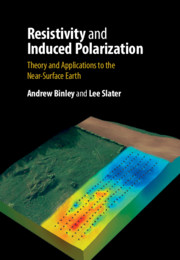Book contents
- Resistivity and Induced Polarization
- Reviews
- Resistivity and Induced Polarization
- Copyright page
- Contents
- Preface
- Acknowledgements
- Symbols
- 1 Introduction
- 2 Electrical Properties of the Near-Surface Earth
- 3 Instrumentation and Laboratory Measurements
- 4 Field-Scale Data Acquisition
- 5 Forward and Inverse Modelling
- 6 Case Studies
- 7 Future Developments
- Appendix A Modelling Tools
- References
- Index
- Plate Section (PDF Only)
5 - Forward and Inverse Modelling
Published online by Cambridge University Press: 17 December 2020
- Resistivity and Induced Polarization
- Reviews
- Resistivity and Induced Polarization
- Copyright page
- Contents
- Preface
- Acknowledgements
- Symbols
- 1 Introduction
- 2 Electrical Properties of the Near-Surface Earth
- 3 Instrumentation and Laboratory Measurements
- 4 Field-Scale Data Acquisition
- 5 Forward and Inverse Modelling
- 6 Case Studies
- 7 Future Developments
- Appendix A Modelling Tools
- References
- Index
- Plate Section (PDF Only)
Summary
In this chapter, we introduce the concepts of forward and inverse modelling of resistivity and induced polarization (IP) measurements.We provide a comprehensive account of the elements that form the majority of modern techniques for resistivity and IP modelling. 1D forward modelling is discussed, building on analytical approaches presented in Chapter 4.For 2D and 3D forward modelling, numerical (discrete) approaches are required, typically adopting finite difference or finite element methods. Inverse modelling, which provides the spatial (or spatio-temporal) variation of a property of interest, is essential for interpretation of resistivity and IP data.We detail various inverse modelling approaches for resistivity and IP data. We illustrate how a priori information can be used to enhance an inverse model and show how data errors can impact on the computed model of electrical properties. Extension of the inverse modelling to treat time-lapse data is explained.Various methods for inverse model appraisal (including model uncertainty) are presented. We illustrate alternative inverse modelling approaches that are based on probabilistic approaches. The inverse modelling of spectral IP data for recovery of relaxation parameters is also discussed.
Information
- Type
- Chapter
- Information
- Resistivity and Induced PolarizationTheory and Applications to the Near-Surface Earth, pp. 213 - 274Publisher: Cambridge University PressPrint publication year: 2020
Accessibility standard: Unknown
Why this information is here
This section outlines the accessibility features of this content - including support for screen readers, full keyboard navigation and high-contrast display options. This may not be relevant for you.Accessibility Information
- 1
- Cited by
